AMD's Phenom II X4 TWKR: We Give It The LN2 Treatment
TWKR, All Boxed Up

Two AMD Phenom II X4 42 Black Edition TWKR (whew, that's a mouthful) CPUs, side by side. This is a picture that you'll likely not see anywhere else. After all, these are pretty rare chips. The TWKR-edition CPUs are currently the most sought-after and coveted AMD processors in the world, at least if you're a hardcore overclocker. Ever since pictures of the TWKR CPUs were leaked a few weeks back, enthusiasts everywhere have been buzzing about them. What hidden superpower do these chips have? What makes these processors so special? Tom's Hardware, along with Team IRONMODS, will put these two chips to the test to see what really makes them tick. But first, here's a bit of background on these unique offerings.
According to AMD, there are approximately 100 TWKR processors in the world. These chips were created especially for the extreme overclocking community to operate beyond the specification of typical production-level processors. What makes these chips special is the fact that they are considered “high leakage” parts. In this context, high leakage means that the processors "leak" more current than a normal Phenom II CPU and consequently run hotter, which actually turns out to be a positive for the overclocking crowd (even if it means they're more likely to die an early death). They can take on more voltage and generally tend to scale higher when cooled with extreme methods, such as liquid nitrogen or liquid helium.
TWKR: “Not For Sale”

If you look closely at the TWKR-edition's heatspreader, you'll see AMD Phenom II 42, TWKR Black Edition, Not for Sale. There is no serial number or any other identification marker. This is because the chip is offered “as-is,” and not covered by AMD's product warranty due to the increased heat and expected shorter life they're destined to live. These chips cannot be purchased (currently), and they are given away at AMD's discretion to members of the overclocking community for the purpose of breaking speed records on specialized test benches. If you're part of that community, you'll want to pay particular attention to this piece, as we have a little surprise in store for you.
The fact that these chips are high leakage components actually makes them undesireable as retail processors. Whereas AMD's flagship Phenom II X4 955 Black Edition falls within AMD's specified thermal limits, these TWKR-edition CPUs do not. They draw more power, generate more heat, and run less efficiently than the chips that AMD sells. The hardcore overclocking community isn't really concerned about efficiency or heat, though. Rather, they're looking for sheer performance, which leads to record-setting benchmark results. This is why AMD's TWKR is so attractive for extreme overclockers and not average users, or even overclockers cooling with air.
Specialized CPU Pots
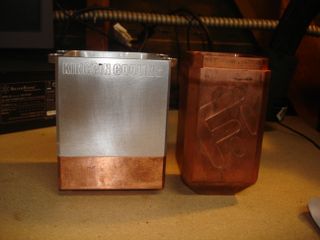
Here are two cooling pots designed and made by K|ngP|n. Cooling pots are more than just containers to hold sub-zero liquids. Each pot is specifically engineered and crafted to effectively remove the heat from the processor and efficiently utilize the cooling substance inside. The Dragon F1 Extreme Edition on the right is currently the best Intel Core i7 pot on the market. Its solid copper mass allows an overclocker to control and maintain the temperature of the processors to within a few degrees. This is critical for Intel Core i7 processors that run hot and suffer from both a cold bug and cold boot bug. More on what a cold bug actually is in just a moment.
The big pot on the left is the latest Venom Liquid Nitrogen pot, which has been designed specifically for the AMD Phenom II processors. The extra copper mass allows the CPU to maintain consistent temperature at very high voltages, while the huge chamber allows for maximum LN2 volume to keep the processors as cold as possible.
In the past, most processors have had issues preventing them from performing below a certain temperature. This is known as a cold bug. Cold bugs can vary greatly, manifesting themselves in different ways. Some will cause general instability below a certain temperature, while others will completely lock up the machine. Fortunately, the Phenom II has no such cold bug. In fact, Phenom II has been proven to scale better the colder it gets. To prove this, AMD has demonstrated the Phenom II hitting unbelievable clock rates while being cooled with liquid helium (almost 70 degrees C colder than liquid nitrogen).
Stay on the Cutting Edge
Join the experts who read Tom's Hardware for the inside track on enthusiast PC tech news — and have for over 25 years. We'll send breaking news and in-depth reviews of CPUs, GPUs, AI, maker hardware and more straight to your inbox.
Insulation
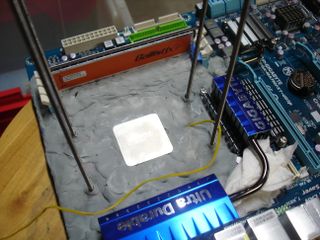
Since the Phenom II (and by extension, these TWKR CPUs) have no cold bugs, the processors will run at very cold temperatures for extended periods of time. Proper insulation is important if you want to maintain the life of your processors and components. Running at sub-zero temperatures usually results in condensation and frost build-up. To prevent components from shorting out from condensation, a large area around the processor socket is covered with kneadable eraser.
Kneadable eraser has some very good characteristics, making it a common piece of material in many overclockers' toolboxes. First, the material is very pliable. It has a slightly firmer texture than Play-Doh and modeling clay. The composition of the eraser allows the material to be flattened and shaped to fit around any curves and crevices. This helps create an air-tight seal around the motherboard and prevent moisture from building up. In addition, kneadable eraser does not break or crack under extreme conditions. Once the bench session is done, the eraser can be easily removed with no residue on the board, and then rolled into a ball for future applications.
After the board has been insulated, the pot has to follow with a similar treatment. The pot itself is covered with 1/2” foam insulation and wrapped with paper towels. The foam insulation helps the pot maintain its temperature, while the paper towel removes any condensation that forms on the side of the foam. Once the pot and motherboard have been properly insulated, thermal paste is applied and the pot is fastened onto the board for some a very fun benching.
Breaking Out The Gear
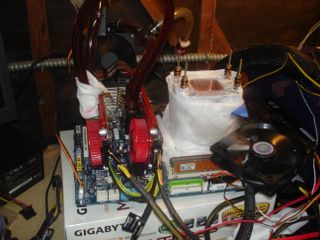
When performing extreme overclocking with LN2, it is very important to use the highest-quality equipment possible. There is nothing more frustrating than a mediocre component limiting your benchmark potential. Each components used for this test run has been carefully scrutinized to maximize overclocking performance.
Here is a list of components that were hand-selected for this bench session:
Processors: AMD Phenom II X4 42 Black Edition TWKRCPU Cooling
: Venom and Dragon F1 EE
Motherboard: Gigabyte MA790FXT-UD5PMemory
: 2 x 1 GB Crucial Ballistix PC-18000 DDR3PowerSupply
: Silverstone Decathlon 1,200 WattGraphics Cards
: 2 x Sapphire Radeon HD 4890Hard Drive
: Western Digital Raptor 10K RPMVideo Card Cooling
: Danger Den Maze 4 GPU and 240mm Black Ice Xtreme
Filling The Pot With LN2
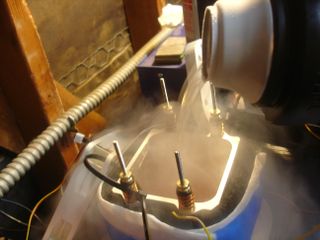
With the AMD TWKR-edition processor strapped onto the motherboard and the pot mounted tight, it is time to start the LN2 bench session. As the LN2 is poured into the pot, it quickly boils off as the temperature of the pot drops. It take approximately 1-2 liters of LN2 before the pot reaches approximately -180 C. Once the pot reaches the optimal temperature, LN2 will be poured sparingly to maintain that temperature. LN2 consumption will vary based on the amount of voltage sent to the processors, as well as the clock rate and processing load.
If these chips aren't subject to the limitations of a cold bug, why are we not using liquid helium for the most insane overclocking experience possible? There are two key factors that make liquid helium unattractive for benching. First, helium costs approximately five times more than nitrogen. LN2 can be purchase for around $1 to $2 a liter, while liquid helium can range from $5 to $8 a liter. Secondly, liquid helium also burns off a lot faster than nitrogen. A 160 L Dewar of liquid helium can be used up in a matter of hours. Unlike LN2, which can be poured into a thermos, liquid helium has to be dispensed directly from the Dewar and into the pot. Liquid helium benching would be ideal once the entire system has been dialed in with nitrogen first.
Max CPUz Stable Clock
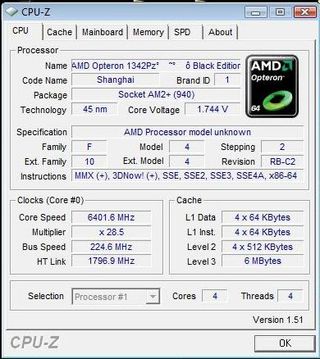
So, how fast can these processors go? It turns out that AMD's binning, which filters out these high leakages parts, works in favor of the extreme overclocker. Pushing approximately 1.75 V to the CPU, we were able to hit 6.4 GHz. Could the processor hit even higher frequencies? We are pretty sure it could with even more voltage and better cooling. We did not try more than 1.75 V on this chip for fear that we'd cut its already-destined-to-be-short life even shorter, or even kill it on the bench. We have a lot more tests that still need to be run and a dead CPU doesn't perform well.
Is it possible that your retail Phenom II X4 955 Black Edition processor might perform as well or better than one of these TWKR chips? The simple answer is, yes. The chances are fairly slim, though. With the TWKR, extreme overclockers know that the chip they have in their hand has all the attributes of an exceptional performer.
The speed that can be achieved by one of these processors is neither guaranteed nor predictable. Just like retail processors, the overclocking headroom on each chip will vary. At its default settings, the TWKR boots at 2 GHz (10 x 200 MHz). Under more traditional cooling methods (air, water, phase change, and cascade), the TWKR will probably perform similar to retail Phenom II Black Edition offerings. Indeed, the Phenom II X4 42 BE TWKR is designed to shine under extreme sub-zero cooling with LN2 and LHe.
Freeze The TWKR For Best Performance
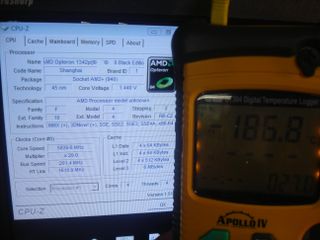
There is a misconception that, in order to get higher speeds, all you need is higher voltage. That statement is not always correct. The key in achieving higher clock rates is efficiently using the power supplied to the processor. If you look at the photo above, you can see that we were able to reach 5.8 GHz with only 1.44 V to the processor (1.45 V set in the motherboard's BIOS). This is the same amount of voltage that many overclockers on air and water use with their Phenom IIs. The difference is that the processor is at approximately -187 C. With LN2 cooling, the processor is able to run very efficiently. And with even better cooling, it is possible that the CPU would run even faster with the same voltage.
Benchmark Results: 3DMark03

Since this TWKR chip is designed for for extreme overclocking, running desktop applications and gaming benchmarks did not seem suitable. These processors are not meant to be operated 24/7; rather, they're designed for benchmarking in the types of apps used by overclockers to set records. These benchmarks are initial results. With more time and LN2, the scores can definitely be optimized. This is a low-voltage 3DMark03 run.
With the TWKR running at 5.6 GHz (at 1.48 V) and only 2 video cards, we were able to achieve a score of approximately 125,000 points.
Benchmark Results: 3DMark05
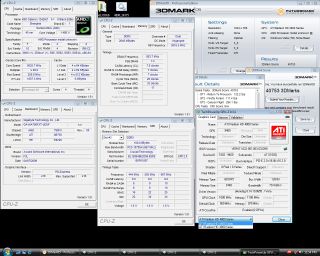
In 3DMark05, the Phenom II X4 42 TWKR is running at 5.6 GHz (at less than 1.5 V). Paired to a couple of Radeon HD 4890s, we were able to break the 40,000 point barrier.
Benchmark Results: 3DMark06

This was the last benchmark we were able to run before our supply of LN2 ran out. The screen shot is only at 5.3Ghz with voltage cranked up to 1.74 V. With voltage cranked up all the way, we were able to see that the processor was very sensitive to temperature. If it heated up a few degrees, it would instantly BSOD. This at least suggests that the CPU would scale even better if we had access to some helium, for example.
We were unable to run 3DMark06 at the magical 6 GHz level on all four cores. With no more LN2, the 6 GHz benches will have to be postponed until another time.
-
scook9 Well that is quite the processor. I hope they aren't going to use these to "show off" the Phenom II x4 line suggesting that these are comparable parts. This is a product that was specifically engineered for this use after all, not representative of the consumer offerings. I am very interested to see what quad 4890's are capable of.Reply -
raptor550 I guess my CPU is holding back my GPU. I'm interested in setting up some home made water cooling to get some extra frames.Reply -
bk420 I think tom's hardware should have used Liquid Helium like the people that broke the last AMD record. They might be able to the same. Great Article, I hope AMD will at least produce a limited series.Reply
Will water cooling be enough for this CPU? If so count me in. -
playerone Great article. But I think this just kind of backfires, most of us would really like to get our hands on a better chip and can't. The latest 955 is really no better than the 940 when it comes to overclocking and it is very likely that the 965 due out shortly will be the same.Reply
My January bought 940 and just bought Asus N4M82 combo runs nicely at 3.9 on air and though I'm not done with it yet I don’t expect it to go much further while being stable. I could actually get a slower 955 if I where to buy right now.
What I would actually have liked to see would have been the soon to be released 965 and see how that does on some good air and water cooling rather than some chip that none of us can get our hands on. Will the 965 be a better overclocker, able to break 4gigs stable more consistently? Very doubtful.
Though this was cool (ha), its just stupidly impractical for those that like extreme overclocking but actually also use their computer. Thanks for the show.
-
Schip scook9Well that is quite the processor. I hope they aren't going to use these to "show off" the Phenom II x4 line suggesting that these are comparable parts. This is a product that was specifically engineered for this use after all, not representative of the consumer offerings. I am very interested to see what quad 4890's are capable of.Reply
You're absolutely right that these chips are not representative of the Phenom II line up at all. However, AMD designed the whole phenom II line up to be very overclocker friendly and these TWKR parts are "just a handpicked and binned processor" as stated here at Legit Reviews. Clearly if these TWKR processors were engineered this way, they could more easily be reproduced and then sold. Cheers!
Most Popular






